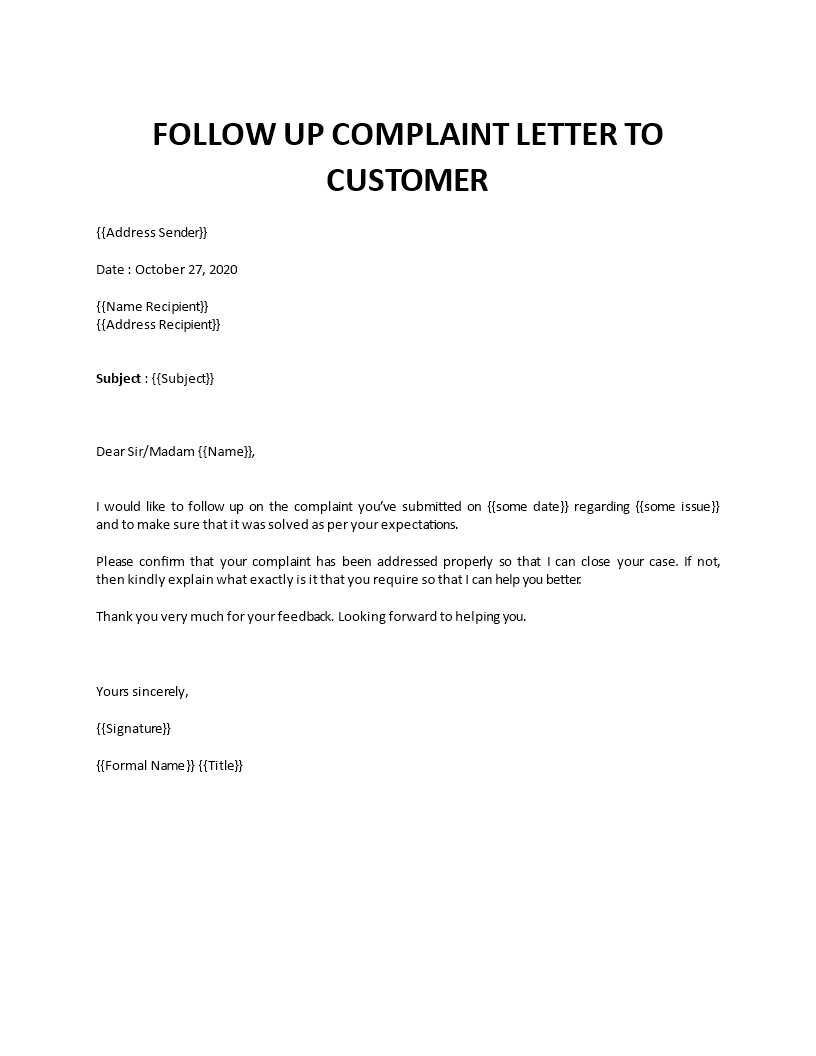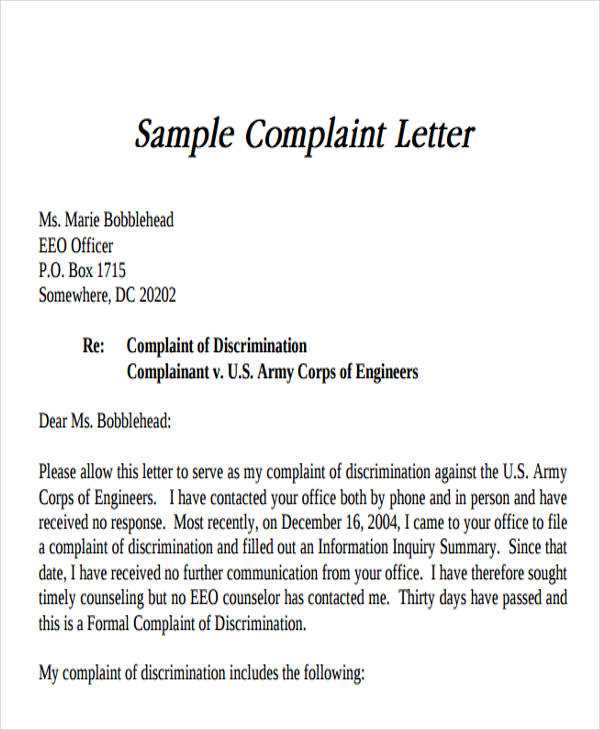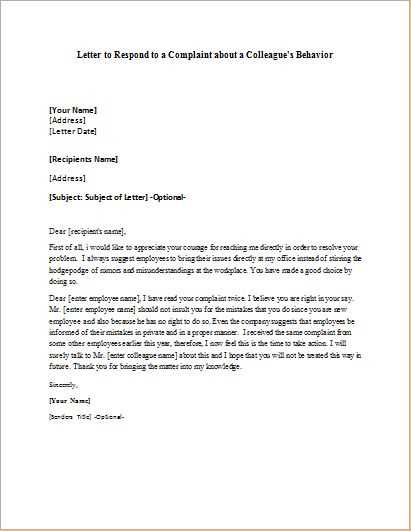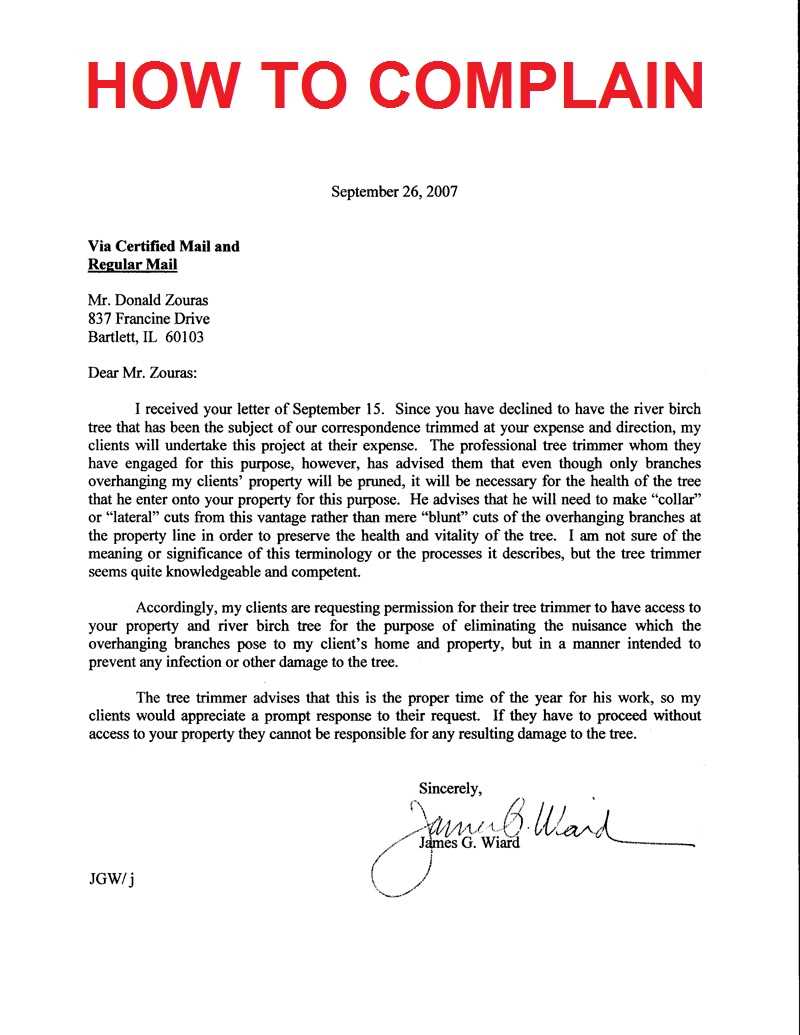Responding to a complaint letter template

Start your response with a clear acknowledgment of the issue raised. Show that you understand the complaint and validate the person’s feelings. For example, you might say, “Thank you for bringing this matter to our attention. We understand your frustration and apologize for any inconvenience caused.”
Next, explain the steps taken to address the situation. Be specific and direct about what actions have been, or will be, taken to resolve the issue. For instance, “We have reviewed the situation and have implemented changes to ensure this doesn’t happen again.”
Conclude by offering a solution or compensation if applicable. Make sure your tone remains respectful and focused on maintaining the relationship. A helpful closing could be, “We hope this solution resolves the issue to your satisfaction, and we appreciate your patience.”
Responding to a Complaint Letter Template
Begin with acknowledging the issue. Directly reference the concern raised, showing that you understand the problem. This helps set a tone of empathy and builds trust with the customer or recipient.
Structure of the Response
- Greeting: Use a polite and professional greeting. For example, “Dear [Name],”
- Acknowledgement: Mention the complaint briefly. Example: “Thank you for reaching out about [issue]. We understand how this situation has caused inconvenience.”
- Apology: Offer a clear and sincere apology. Avoid using vague language. Example: “We sincerely apologize for [specific issue], and we regret the experience it caused.”
- Explanation (if necessary): If relevant, provide a brief explanation of why the issue occurred. Do not make excuses. Example: “This happened due to [reason], and we are addressing it to prevent future occurrences.”
- Action: Describe the steps being taken to resolve the matter. Example: “We are [actions you are taking] to make sure this doesn’t happen again.”
- Resolution or Offer: Provide a solution or compensation if possible. Example: “To make things right, we would like to offer [solution].”
- Closing: Close the letter politely and invite further communication if needed. Example: “Please don’t hesitate to contact us with any further questions.”
Sample Response

Dear [Name],
Thank you for bringing your concern to our attention. We understand your frustration regarding [issue]. We apologize for any inconvenience this may have caused you.
The situation occurred because of [reason]. We have already taken steps to address this, and we are working with [team/department] to ensure it does not happen again.
As a resolution, we would like to offer [compensation, solution]. We hope this will help restore your trust in our service.
If you have any further concerns or need additional assistance, please feel free to contact us at [contact details]. We value your feedback and appreciate your understanding.
Sincerely,
[Your Name]
[Your Position]
Understanding the Key Elements of a Complaint Response
Responding to a complaint requires a clear and thoughtful approach. The core elements should address the issue directly and provide a solution or next steps. Here’s how to structure your response effectively.
1. Acknowledgment of the Issue

Start by acknowledging the complaint. This demonstrates that you’ve understood the concern raised. Acknowledge the frustration or inconvenience caused, ensuring the tone is empathetic but professional.
2. Explanation and Accountability
Clearly explain the situation without making excuses. If there was an error, admit it. Transparency is key. If applicable, outline what led to the issue and how it can be avoided in the future.
3. Offering a Resolution

Offer a practical solution to address the complaint. If a direct resolution is not possible, provide alternatives or next steps. Be clear about the actions you’re taking or have taken to resolve the issue.
4. Closing with Assurance
End the response with reassurance that you value the feedback and are committed to improving. Let the customer know they can reach out for further assistance, reinforcing your willingness to maintain a positive relationship.
How to Acknowledge the Customer’s Concerns in Your Reply
Start by directly addressing the customer’s issue, showing you understand their frustration or disappointment. Acknowledge their experience without sounding dismissive or overly apologetic.
For example, if the customer is unhappy with a product’s quality, specifically mention the problem. Avoid vague statements like “We understand your concerns.” Instead, focus on the actual issue: “I see that the product you received did not meet your expectations in terms of durability.”
Next, express empathy. Acknowledge that the situation has caused inconvenience or frustration. A simple acknowledgment like, “I can imagine how this situation would be frustrating,” helps to show you are on their side.
Use language that communicates you take their feedback seriously. Avoid distancing terms like “we’ve received your complaint.” Instead, use more personal, action-oriented language such as: “We are reviewing your issue closely to find the best solution.” This shows a commitment to resolving the problem.
Ensure that your tone remains friendly and professional. The goal is to maintain trust, so your words should convey understanding without being overly formal or robotic.
Here’s a simple breakdown of what to do:
| Step | Action |
|---|---|
| Acknowledge the Concern | Address the specific issue directly, showing you understand the problem. |
| Show Empathy | Express understanding of the frustration or inconvenience caused. |
| Use Action-Oriented Language | Reassure the customer that you are actively looking into their issue. |
| Maintain a Friendly Tone | Balance professionalism with a friendly approach to keep the conversation positive. |
Crafting a Clear and Concise Apology in Your Response

Apologize directly and sincerely. Acknowledge the issue without over-explaining or making excuses. For example, “I’m sorry we did not meet your expectations with the delivery time.” Keep the focus on the customer’s experience and not on your company’s challenges.
Avoid vague phrases like “We apologize for any inconvenience.” Be specific about what went wrong. If there was a mistake with a product, mention that directly. “Our product did not function as expected” is more clear than simply saying “our product wasn’t up to standard.”
Show empathy. Recognize the frustration or disappointment caused by the situation. Acknowledge the impact it may have had on the customer, such as: “I understand how this delay may have disrupted your plans, and I sincerely apologize for that.” Keep the tone genuine and focused on the customer’s feelings.
Be brief. A concise apology is more effective than a lengthy one. Stick to the point and avoid going in circles. Don’t try to justify the situation excessively or make it about you. Instead, center the conversation on how you will make things right.
Finish by offering a solution or next steps. Show that you’re committed to resolving the issue, such as: “We are processing your refund immediately, and you will receive it within 5 business days.” Giving a clear path forward reassures the customer that the issue will be handled efficiently.
Offering a Practical Solution to Resolve the Complaint
Begin by acknowledging the specific issue raised in the complaint. Offer a clear solution that directly addresses the concern, and include any actions you are taking to fix it. For example, if the complaint is about a product defect, propose a replacement, refund, or repair, based on the situation.
Action Steps to Address the Complaint
Outline the exact steps you will take to resolve the matter. This provides clarity and demonstrates your commitment to solving the issue. If the issue involves service delays, offer a timeline and guarantee that the problem will be addressed within a set period. If additional resources are needed, clearly state what is required and the expected timeframe.
Maintaining Customer Trust
Reassure the customer that their concerns are being taken seriously and that their satisfaction is a priority. Offer a gesture of goodwill, such as a discount on future purchases or an extra service, if appropriate. This will help reinforce the relationship and show that you value their feedback.
Maintaining a Professional and Courteous Tone Throughout the Letter
Always begin with a polite and respectful opening. Acknowledge the customer’s concerns and express your commitment to resolving the issue. Phrases like, “Thank you for reaching out to us” or “We appreciate you bringing this matter to our attention” set a constructive tone for the rest of the letter.
Stay Focused on Solutions
Keep your language clear and solution-oriented. Avoid defensive language that may escalate the situation. Instead, use phrases like, “We are investigating the issue” or “Here’s what we can do to address the concern.” This shows that you are taking action without sounding dismissive of the complaint.
Use Positive and Neutral Language
Even if the complaint is frustrating, maintain a neutral tone. Choose words that encourage resolution rather than deepen dissatisfaction. Instead of saying “You misunderstood our policy,” try “We understand how this may have been confusing.” This keeps the conversation on track and avoids further alienation.
Always close the letter on a positive note. Reaffirm your commitment to customer satisfaction and encourage the customer to reach out again if necessary. A simple “We look forward to resolving this promptly” or “Please don’t hesitate to contact us for further assistance” leaves a friendly, approachable impression.
When to Follow Up After Sending Your Response
Follow up within a week if you haven’t received a response after sending your initial reply. This gives the recipient enough time to process your response and gather their thoughts, but still allows for a timely check-in.
Consider a follow-up if:
- You promised additional information or action and haven’t received confirmation yet.
- The recipient’s response time is unclear or they didn’t mention a specific timeline for follow-up.
- You are waiting for a decision that impacts your next steps or operations.
- The issue is urgent, and further delay could negatively affect the relationship or situation.
How to follow up effectively:
- Keep your tone polite and professional. Acknowledge the previous correspondence and show understanding of their possible workload.
- Be specific about your inquiry. Clearly state the reason for following up and any actions or decisions that are pending.
- Limit your follow-ups to two or three attempts, spaced out to avoid overwhelming the recipient.